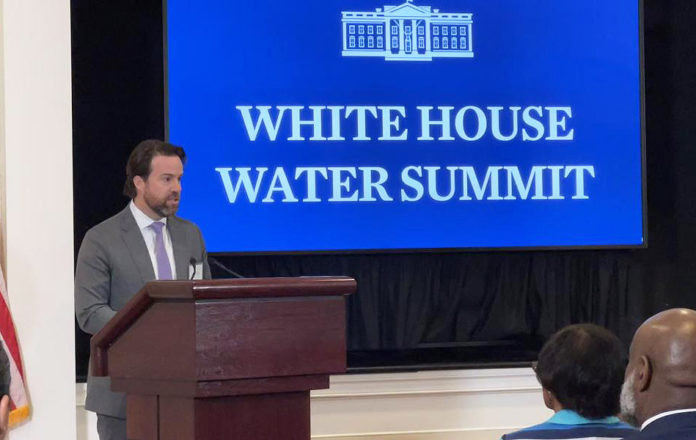Interior Announces Interagency Effort To Support Tribal Water
Interior Announces Interagency Effort To Support Tribal Water, Sanitation Infrastructure Indian Gaming


Department of the Interior and Indian Health Service Collaborate on Safe Drinking Water Projects in Indian Country

Introduction
WASHINGTON, D.C. – The Department of the Interior’s Bureau of Reclamation and Indian Health Service (IHS) have signed a Memorandum of Understanding (MOU) to collaborate on the development of safe drinking water and community sanitation infrastructure projects in Indian Country. This announcement was made by Principal Deputy Assistant Secretary for Water and Science Michael Brain at the White House’s inaugural Clean Water Summit. The event also featured Indian Health Service Deputy Director Benjamin Smith and Yakama Nation Chairman Gerald Lewis. Reclamation Commissioner Camille Calimlim Touton highlighted Reclamation’s investments in climate and drought resilience in the Western region during a panel discussion at the summit.
Collaboration for Safe Drinking Water Projects
Under the Memorandum of Understanding, the Bureau of Reclamation and Indian Health Service will work together to conduct studies, planning, and design activities for the construction of domestic water infrastructure projects. The aim is to expedite the completion of these facilities in tribal communities. This collaboration aligns with President Biden’s Executive Order 14112, which calls for federal agencies to collaborate and streamline tribal access to resources.
Importance of Modern Water Infrastructure
Principal Deputy Assistant Secretary for Water and Science Michael Brain emphasized the significance of modern water infrastructure for the health of communities and economic opportunities. He stated that this new agreement, along with the resources from President Biden’s Investing in America agenda, represents a significant step towards ensuring essential water and sanitation infrastructure throughout Indian Country.
Commissioner Camille Calimlim Touton added that the all-of-government approach of the administration allows for leveraging funds from historic investments to further support tribal communities. Reclamation is pleased to explore opportunities for projects with the Yakama Nation and other tribes to implement the MOU.
Pilot Project on the Yakama Reservation
A potential pilot project has been identified on the Yakama reservation in Washington State. Following an engineering investigation by the Indian Health Service, it was confirmed that the water system in the small community of Georgeville has high levels of arsenic. The Yakama Nation and IHS have agreed to construct a treatment system using funding from the Bipartisan Infrastructure Law to remove arsenic from the water supply. The Bureau of Reclamation will provide technical support for this project and future initiatives through the MOU.
Improving Public Health in Native American Communities
Indian Health Service Director Roselyn Tso highlighted the importance of safe and reliable water systems for public health. She expressed appreciation for the Biden administration’s historic multi-billion-dollar investment in water and sanitation infrastructure in Indian Country. The collaboration with the Bureau of Reclamation will accelerate the completion of critical projects and reduce barriers for tribal nations to partner with the agencies.
Commitment to Tribal Water Infrastructure
In 2022, Reclamation joined the Federal Infrastructure Task Force to enhance access to safe drinking water and basic sanitation in tribal communities. With the additional resources provided through the Bipartisan Infrastructure Law and Inflation Reduction Act, the Bureau has allocated significant funding for tribal water infrastructure projects. Recently, $320 million was made available for tribal domestic water supply projects, as part of a total allocation of $550 million through the Inflation Reduction Act and President Biden’s Justice40 Initiative. The Indian Health Service has been investing $3.5 billion from the Biden-Harris administration in water and sanitation projects, with $700 million allocated for fiscal year 2024.
SDGs, Targets, and Indicators in the Article
1. Which SDGs are addressed or connected to the issues highlighted in the article?
- SDG 3: Good Health and Well-being
- SDG 6: Clean Water and Sanitation
- SDG 9: Industry, Innovation, and Infrastructure
- SDG 13: Climate Action
The article discusses the development of safe drinking water and community sanitation infrastructure projects across Indian Country, which directly relates to SDG 3 (ensuring good health and well-being) and SDG 6 (ensuring clean water and sanitation). The collaboration between the Bureau of Reclamation and Indian Health Service also highlights the importance of infrastructure development, which aligns with SDG 9. Additionally, the mention of investments in climate and drought resilience connects to SDG 13, which focuses on climate action.
2. What specific targets under those SDGs can be identified based on the article’s content?
- SDG 3.8: Achieve universal health coverage, including access to safe, effective, quality, and affordable essential medicines and vaccines for all
- SDG 6.1: Achieve universal and equitable access to safe and affordable drinking water for all
- SDG 6.2: Achieve access to adequate and equitable sanitation and hygiene for all
- SDG 9.1: Develop quality, reliable, sustainable, and resilient infrastructure, including regional and transborder infrastructure, to support economic development and human well-being
- SDG 13.1: Strengthen resilience and adaptive capacity to climate-related hazards and natural disasters
The targets identified in the article include achieving universal health coverage and access to safe drinking water and sanitation facilities (SDG 3.8, SDG 6.1, and SDG 6.2). The development of infrastructure projects for water and sanitation aligns with SDG 9.1. The focus on climate and drought resilience corresponds to the target of strengthening resilience to climate-related hazards (SDG 13.1).
3. Are there any indicators mentioned or implied in the article that can be used to measure progress towards the identified targets?
- Indicator 3.8.1: Coverage of essential health services
- Indicator 6.1.1: Proportion of the population using safely managed drinking water services
- Indicator 6.2.1: Proportion of the population using safely managed sanitation services
- Indicator 9.1.1: Proportion of the rural population who live within 2 km of an all-season road
- Indicator 13.1.1: Number of deaths, missing persons, and directly affected persons attributed to disasters per 100,000 population
The article does not explicitly mention specific indicators, but based on the targets identified, the following indicators can be used to measure progress:
– Indicator 3.8.1 measures the coverage of essential health services, which can be used to assess progress towards achieving universal health coverage.
– Indicator 6.1.1 measures the proportion of the population using safely managed drinking water services, indicating progress towards universal access to safe drinking water.
– Indicator 6.2.1 measures the proportion of the population using safely managed sanitation services, indicating progress towards universal access to sanitation and hygiene.
– Indicator 9.1.1 measures the proportion of the rural population living within 2 km of an all-season road, which can be used to assess infrastructure development.
– Indicator 13.1.1 measures the impact of disasters on the population, reflecting the resilience and adaptive capacity to climate-related hazards.
Table: SDGs, Targets, and Indicators
| SDGs | Targets | Indicators |
|---|---|---|
| SDG 3: Good Health and Well-being | Target 3.8: Achieve universal health coverage, including access to safe, effective, quality, and affordable essential medicines and vaccines for all | Indicator 3.8.1: Coverage of essential health services |
| SDG 6: Clean Water and Sanitation | Target 6.1: Achieve universal and equitable access to safe and affordable drinking water for all | Indicator 6.1.1: Proportion of the population using safely managed drinking water services |
| Target 6.2: Achieve access to adequate and equitable sanitation and hygiene for all | Indicator 6.2.1: Proportion of the population using safely managed sanitation services | |
| SDG 9: Industry, Innovation, and Infrastructure | Target 9.1: Develop quality, reliable, sustainable, and resilient infrastructure, including regional and transborder infrastructure, to support economic development and human well-being | Indicator 9.1.1: Proportion of the rural population who live within 2 km of an all-season road |
| SDG 13: Climate Action | Target 13.1: Strengthen resilience and adaptive capacity to climate-related hazards and natural disasters | Indicator 13.1.1: Number of deaths, missing persons, and directly affected persons attributed to disasters per 100,000 population |
Behold! This splendid article springs forth from the wellspring of knowledge, shaped by a wondrous proprietary AI technology that delved into a vast ocean of data, illuminating the path towards the Sustainable Development Goals. Remember that all rights are reserved by SDG Investors LLC, empowering us to champion progress together.
Source: indiangaming.com

Join us, as fellow seekers of change, on a transformative journey at https://sdgtalks.ai/welcome, where you can become a member and actively contribute to shaping a brighter future.








